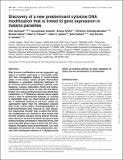Discovery of a new predominant cytosine DNA modification that is linked to gene expression in malaria parasites
Author(s)
Hammam, Elie; Ananda, Guruprasad; Sinha, Ameya; Scheidig-Benatar, Christine; Bohec, Mylene; Preiser, Peter R; Dedon, Peter C; Scherf, Artur; Vembar, Shruthi S; ... Show more Show less
DownloadPublished version (3.834Mb)
Publisher with Creative Commons License
Publisher with Creative Commons License
Creative Commons Attribution
Terms of use
Metadata
Show full item recordAbstract
DNA cytosine modifications are key epigenetic regulators of cellular processes in mammalian cells, with their misregulation leading to varied disease states. In the human malaria parasite Plasmodium falciparum, a unicellular eukaryotic pathogen, little is known about the predominant cytosine modifications, cytosine methylation (5mC) and hydroxymethylation (5hmC). Here, we report the first identification of a hydroxymethylcytosine-like (5hmC-like) modification in P. falciparum asexual blood stages using a suite of biochemical methods. In contrast to mammalian cells, we report 5hmC-like levels in the P. falciparum genome of 0.2-0.4%, which are significantly higher than the methylated cytosine (mC) levels of 0.01-0.05%. Immunoprecipitation of hydroxymethylated DNA followed by next generation sequencing (hmeDIP-seq) revealed that 5hmC-like modifications are enriched in gene bodies with minimal dynamic changes during asexual development. Moreover, levels of the 5hmC-like base in gene bodies positively correlated to transcript levels, with more than 2000 genes stably marked with this modification throughout asexual development. Our work highlights the existence of a new predominant cytosine DNA modification pathway in P. falciparum and opens up exciting avenues for gene regulation research and the development of antimalarials.
Date issued
2019-11Department
Massachusetts Institute of Technology. Department of Biological EngineeringJournal
Nucleic Acids Research
Publisher
Oxford University Press (OUP)
Citation
Hammam, Ellie et al. "Discovery of a new predominant cytosine DNA modification that is linked to gene expression in malaria parasites." Nucleic Acids Research 48, 1 (November 2019): 184–199 © 2019 The Author(s)
Version: Final published version
ISSN
0305-1048
1362-4962